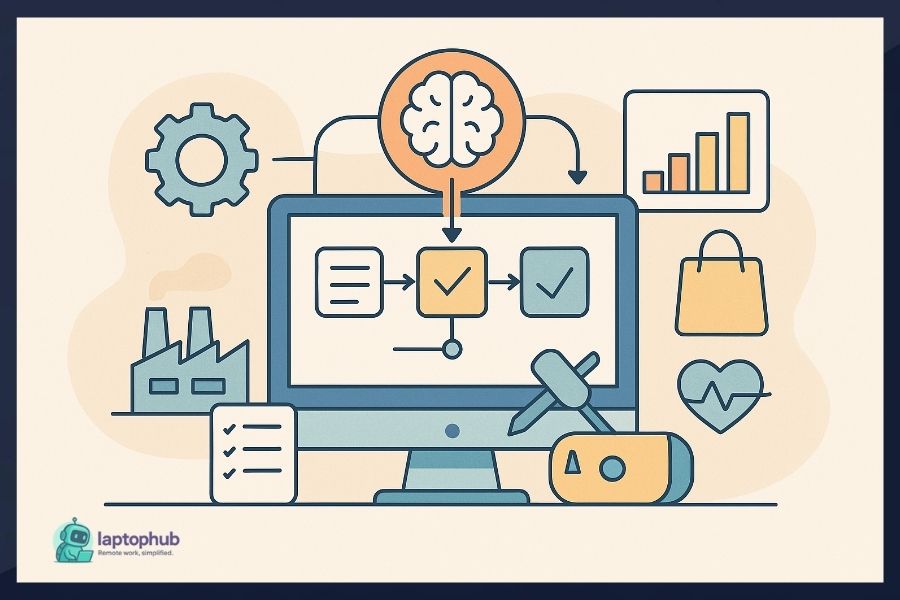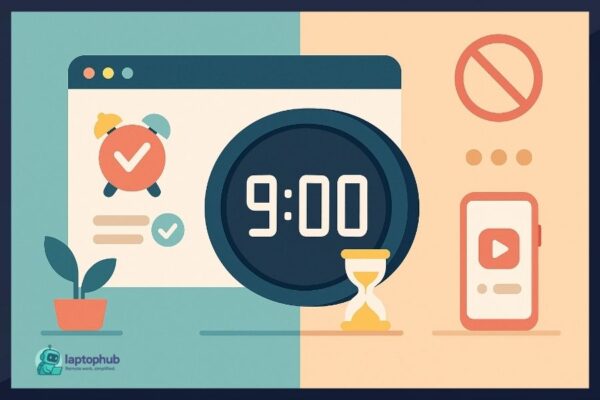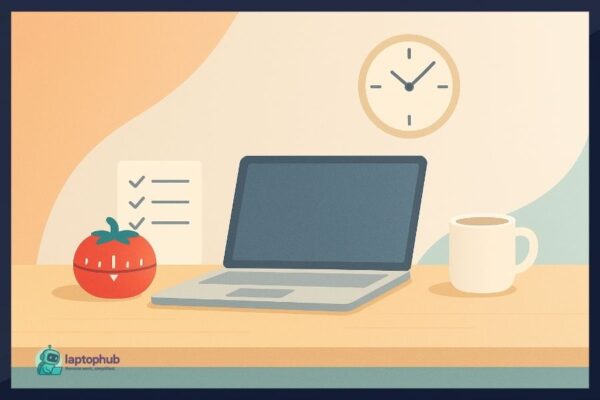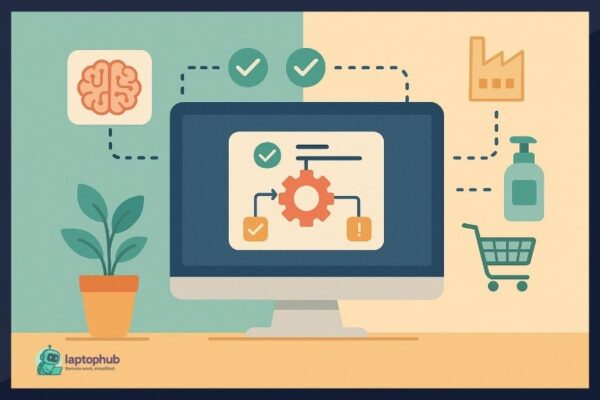Remote work isn’t just a pandemic trend—it’s the future of how we live and work. But while working in pajamas sounds like a dream, it can quickly become a productivity nightmare without structure. Whether you’re freelancing, managing a distributed team, or logging into Zoom for your 9–5, the challenge is the same: how do you stay focused, energized, and effective from the comfort of home? This guide uncovers battle-tested remote work productivity tips that help you thrive—not just survive—in a remote world.
💡Key takeaways:
- Creating a structured and ergonomic workspace is essential for focus and efficiency in remote work.
- Personalized routines like time blocking and task batching help maintain productivity and reduce burnout.
- Managing distractions and using the right tools ensures better communication and workflow continuity.
- Taking care of mental health and tracking productivity leads to long-term remote work success.
Remote Work Reality
The Rise and Permanence of Remote Work
Remote work exploded globally following the COVID-19 pandemic and hasn’t slowed down. According to Gallup, nearly 56% of U.S. workers are “always” or “sometimes” working remotely in hybrid or fully remote roles. For many, it’s here to stay.
Common Productivity Pitfalls to Avoid
Even seasoned remote workers can fall into productivity traps. The home environment, while comfortable, is full of hidden obstacles that can quietly sabotage your focus and workflow.
1. Lack of Clear Boundaries:
When the lines between “home” and “office” blur, it’s easy to overwork or underperform. Avoid hopping on your laptop while still in bed or answering work emails during family dinner. Create physical and time boundaries—like a dedicated workspace and clear sign-off hours—to maintain balance.
2. Multitasking Mayhem:
Contrary to popular belief, multitasking doesn’t make you more efficient. It actually reduces your output and increases mistakes. Focus on one task at a time using the Pomodoro technique or task batching to work smarter.
3. Ignoring Health Signals:
Skipping meals, sitting for hours, or ignoring signs of burnout leads to decreased energy and lower productivity. Remote workers often neglect self-care in the name of efficiency—when in reality, it has the opposite effect.
4. Inconsistent Routines:
Without a regular schedule, procrastination creeps in. While flexibility is a remote work perk, too much of it leads to disorganization. Create a repeatable morning routine and define work hours to anchor your day.
🧠 Pro Tip: Keep a productivity journal to track what’s draining your energy or stealing your time. Tools like Toggl and RescueTime can provide valuable data to help you identify weak spots.
Setting Up for Success
Create a Designated Workspace
Even if you live in a studio apartment, carving out a “work-only” zone improves mental clarity. It tells your brain, “This is where work happens.” Check out Amazon’s small-space desk setups for affordable ideas.
Invest in Ergonomics for Better Focus
Back pain kills productivity. Try an adjustable chair, wrist support, and a laptop stand. The Mayo Clinic offers a fantastic guide to ergonomic office setups.
Must-Have Tools and Software for Remote Work
- Video Calls: Zoom, Google Meet
- Project Management: ClickUp, Asana
- Note-Taking: Notion, Evernote
- Communication: Slack, Microsoft Teams
📖Also read: AI for Remote Work: How Smart Tools Are Reshaping the Workplace
Building a Personalized Work Routine
When it comes to working remotely, there’s no one-size-fits-all schedule. That’s the beauty of it—you get to design a routine that works with your natural rhythms, lifestyle, and responsibilities. But without structure, flexibility can quickly become chaos. A personalized routine is like your remote work roadmap—clear, reliable, and easy to follow.
1. Know Your Productivity Peaks
We all have different internal clocks. Some people crush their to-do list before 10 a.m., while others hit their stride after lunch. Pay attention to your body’s natural rhythms for a week—when do you feel sharpest? Most creative? Easily distracted?
🧠 Tip: Use a simple time audit with tools like Clockify to monitor your energy levels and task completion throughout the day. Once you spot your patterns, build your toughest tasks around those high-energy hours.
2. Embrace Time Blocking
Time blocking is a game-changer for remote productivity. It involves assigning specific time slots for specific tasks, which reduces decision fatigue and keeps you focused.
Here’s how to get started:
- Block off deep work hours (for writing, designing, coding, etc.)
- Add short breaks every 60–90 minutes
- Batch similar tasks like email, admin, or meetings
📅 Pro Tip: Try tools like Google Calendar, Notion, or Sunsama for easy visual planning.
3. Set Anchors in Your Day
Anchors are fixed points in your schedule that add consistency to your routine. Think of them as your “bookends” for each day—your morning startup and evening shutdown rituals.
Examples of time anchors:
- Morning coffee and journaling at 8:00 AM
- Midday walk or stretch at 1:00 PM
- Final email check at 4:30 PM
Anchors help prevent burnout and give your day a sense of rhythm, especially when your workload fluctuates.
4. Include Transitions Between Work and Life
One of the biggest remote work struggles? Shutting down at the end of the day. Without a commute or physical boundary, work can bleed into your evenings and weekends.
Here’s how to solve it:
- Create an “end-of-day” routine (e.g., review your to-do list, tidy your workspace, close all tabs)
- Change your environment—go outside, change clothes, or listen to music
- Set an automatic Slack or email status that signals you’re offline
🔁 Idea: Use the “fake commute” strategy—walk around the block before and after your work hours to mentally shift between home and office mode.
5. Revisit and Tweak Regularly
Your ideal routine won’t happen overnight—and it shouldn’t stay static either. As your workload, family needs, or energy levels change, so should your schedule.
Try this:
- Every Friday, reflect on what worked and what didn’t
- Adjust your time blocks based on that insight
- Experiment with new productivity methods, like the 2-Minute Rule or MIT (Most Important Task) system
❗ Remember: The best routine is the one you’ll actually stick to. Build it around what fuels you—not what looks good on paper.
Eliminating Distractions at Home
Your home is your castle—but it’s also where most distractions live. From noisy neighbors to tempting Netflix episodes, staying on track requires intention and boundaries.
1. Identify Your Top Distractions:
Start by listing out your top 3 distractions. Is it phone notifications? Kids barging in? Social media scrolling? Once you’re aware, you can develop targeted solutions.
2. Use Tech to Block Temptations:
Apps like Freedom, Cold Turkey, and Focus@Will block digital distractions so you can focus on deep work. Set your phone to “Do Not Disturb” and keep it out of arm’s reach.
3. Create a “Focus Zone”:
Designate a distraction-free space, ideally a room with a door you can close. If that’s not an option, use noise-canceling headphones or ambient noise apps like Noisli to create a bubble of focus.
4. Communicate Your Boundaries:
Let your household know your work hours and when you can’t be disturbed. A simple “do not disturb” sign on your chair or desk can work wonders, especially with kids or roommates around.
5. Master Time Blocking:
Schedule deep-focus work for when you’re least likely to be interrupted—often early mornings or late afternoons. Group similar tasks together to avoid task-switching fatigue.
🚧 Quick Tip: Set up a “distraction log” to monitor when and why you break focus. This helps you build awareness and develop stronger habits over time.
Effective Communication Strategies
Transparency and Over-Communication
You’re not in an office. People can’t see your progress. Keep your team updated regularly—status messages, short recaps, weekly goals.
Choosing the Right Communication Channel
- Urgent? Use messaging.
- Complex or emotional? Use video.
- Long-term documentation? Use shared docs like Notion or Confluence.
Collaboration Tools You Should Be Using
Smart Breaks and Energy Management
Working non-stop is not a badge of honor—it’s a fast track to burnout. The most productive remote workers know how to rest as hard as they work.
1. Follow the Ultradian Rhythm:
Your body runs in 90–120 minute productivity cycles. After each focus sprint, take a 10–15 minute break to reset your brain. You’ll come back sharper and more creative.
2. Move Your Body:
Sitting too long can drain energy fast. Use breaks to stretch, take a quick walk, or do some light yoga. Try DeskYogi or follow quick YouTube routines to get moving without leaving your home.
3. Snack Smartly:
Avoid sugar crashes by snacking on brain-friendly foods like nuts, berries, or dark chocolate. Hydration is just as important—keep a water bottle nearby and sip throughout the day.
4. Mental Breaks Count Too:
Use guided meditation apps like Headspace or Insight Timer to recharge mentally. Even 5 minutes of mindful breathing can make a big difference in reducing stress and refueling focus.
5. Try the “Fake Commute”:
Simulate a start and end to your workday by taking a short walk before and after work. It mimics the separation a real commute provides, signaling your brain when it’s time to shift gears.
🌞 Energy Hack: Schedule demanding tasks when your energy peaks. For most people, that’s mid-morning or early afternoon. Use less demanding admin tasks to fill in your low-energy valleys.
Managing Your Mental Health
Spotting the Signs of Burnout
If you’re constantly tired, unmotivated, or irritable—those are red flags. Check out Mind’s guide to burnout.
Staying Social in a Remote World
Book virtual hangouts, coffee chats, or Slack fun channels. Social interaction combats loneliness and lifts morale.
Creating Work-Life Boundaries
Turn off work notifications after hours. Use a different browser or device for personal use. Physically shut down your work setup each night.
Productivity Tracking and Continuous Improvement
Using Time Tracking Tools
Use Toggl, Clockify, or Harvest to see where your hours go—and tweak accordingly.
Conducting Weekly Self-Reviews
Every Friday, reflect: What drained you? What energized you? Adjust next week’s plan to prioritize your best energy zones.
Learning from Data to Optimize Workflows
Tracking patterns in your productivity helps you know when you work best and what to eliminate. Use that insight to level up.
Advanced Remote Work Productivity Hacks
Async Work Culture and Deep Work
Asynchronous work = no pressure to respond instantly. It enables “deep work”—long stretches of distraction-free focus. Read Cal Newport’s take for more.
Automate Repetitive Tasks
Use Zapier or IFTTT to automate workflows like saving email attachments or sending Slack reminders.
Remote Work Productivity FAQs
How do I stay motivated when working from home?
Set clear daily goals, build momentum with small wins, and reward yourself. Having an accountability buddy or checking in with teammates can also help.
What’s the best schedule for remote work?
It depends on your energy levels. Use time tracking to find your peak hours and build your work blocks around them.
How can I avoid distractions from family or roommates?
Communicate boundaries clearly. Use visual cues like a “Working” sign and create a morning routine that prepares everyone for your focused hours.
Do productivity tools really make a difference?
Yes, but only when used intentionally. Too many tools can lead to clutter. Start with essentials like a task manager and time tracker.
How do I prevent burnout while working remotely?
Log off at the end of your shift. Take real breaks, talk to people, and schedule days off. Don’t underestimate the power of stepping away.
Final thoughts
Productivity while working remotely isn’t about squeezing every drop of effort from your day. It’s about working smarter, staying sane, and setting yourself up for long-term success. Create structure, minimize noise, track your output, and don’t forget—breaks are part of the work too. Experiment, find your rhythm, and remote work might just be your most productive chapter yet.




